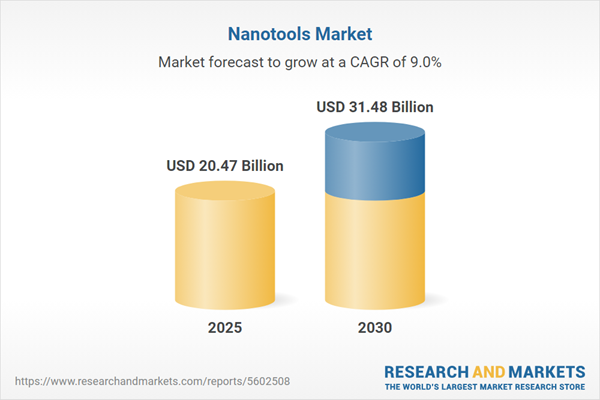The nanotools market refers to the instruments, devices, and software used for fabricating, measuring, and manipulating materials at the nanoscale. The market covers the use of nanotechnology-based tools in research, manufacturing, and various industrial applications.
Market Trends:
- Increasing preference for minimally invasive surgeries: The rising demand for minimally invasive surgeries is driving the growth of the nanotools market, as these tools are integral to such procedures. A study published in the Journal of the Society of Laparoscopic and Robotic Surgeons (US NLM, NIH) in 2020 highlighted a significant increase in minimally invasive surgeries performed by general surgery residents in the U.S. between 2003 and 2019. The study reported growth in procedures such as cholecystectomy (from 88% to 94%), inguinal hernia repair (from 20% to 47%), appendectomy (from 38% to 93%), colectomy (from 8% to 43%), gastrectomy (from 43% to 84%), and Nissen fundoplication (from 71% to 91%).
- Shift towards minimally invasive cosmetic procedures: The cosmetic industry is also embracing minimally invasive techniques, which is expected to further boost the nanotools market. According to the Plastic Surgery Statistics Report by the American Society of Plastic Surgeons, the number of minimally invasive cosmetic procedures in the U.S., such as Botulinum Toxin Type A (Botox, Dysport, Xeomin), surged from 786,911 in 2000 to 4,401,536 in 2020. Overall, minimally invasive cosmetic procedures reached 15,750,363 in 2020, up from 4,847,561 in 2000.
- North America and Asia Pacific to dominate the market: Geographically, North America is expected to hold a significant market share due to the growing demand for minimally invasive surgeries, particularly in the United States. The region's advanced healthcare infrastructure and high adoption rates of innovative technologies, including nanotools, contribute to its market dominance. Meanwhile, the Asia Pacific region is poised for substantial growth, driven by increased healthcare spending and the expanding use of nanotools in industries such as electronics and semiconductors.
Key Benefits of this Report:
- Insightful Analysis: Gain detailed market insights covering major as well as emerging geographical regions, focusing on customer segments, government policies and socio-economic factors, consumer preferences, industry verticals, and other sub-segments.
- Competitive Landscape: Understand the strategic maneuvers employed by key players globally to understand possible market penetration with the correct strategy.
- Market Drivers & Future Trends: Explore the dynamic factors and pivotal market trends and how they will shape future market developments.
- Actionable Recommendations: Utilize the insights to exercise strategic decisions to uncover new business streams and revenues in a dynamic environment.
- Caters to a Wide Audience: Beneficial and cost-effective for startups, research institutions, consultants, SMEs, and large enterprises.
What can businesses use this report for?
Industry and Market Insights, Opportunity Assessment, Product Demand Forecasting, Market Entry Strategy, Geographical Expansion, Capital Investment Decisions, Regulatory Framework & Implications, New Product Development, Competitive Intelligence.Report Coverage:
- Historical data from 2022 to 2024 & forecast data from 2025 to 2030
- Growth Opportunities, Challenges, Supply Chain Outlook, Regulatory Framework, and Trend Analysis
- Competitive Positioning, Strategies, and Market Share Analysis
- Revenue Growth and Forecast Assessment of segments and regions including countries
- Company Profiling (Strategies, Products, Financial Information, and Key Developments among others)
Nanotools Market is analyzed into the following segments:
By Product Type
- Nanolithography
- Microscopes
- Nano-Manipulators
- Nano Machining Tools
- Others
By Application
- Electronics & semiconductors
- Healthcare & Life Sciences
- Material Science and Energy
- Aerospace and Defense
- Others
By End-User Industry
- Electronics and Semiconductor
- Renewable Energy
- Mining
- Metallurgy
- Healthcare
- Biotechnology
- Others
By Region
- Americas
- US
- Europe, Middle East, and Africa
- Germany
- Netherlands
- Others
- Asia Pacific
- China
- Japan
- Taiwan
- South Korea
- Others
Table of Contents
Companies Mentioned
- Heidelberg Instruments
- Thermo Fisher Scientific
- Bruker Corporation
- Oxford Instruments
- Carl Zeiss AG
- Raith GmbH
- Nanonics Imaging Ltd.
- Applied Nanotools
- Nanophase Technologies Corporation
- NIL Technology
- Hitachi High Technology Corporation (SII NanoTechnology Inc.)
Table Information
| Report Attribute | Details |
|---|---|
| No. of Pages | 152 |
| Published | March 2025 |
| Forecast Period | 2025 - 2030 |
| Estimated Market Value ( USD | $ 20.47 Billion |
| Forecasted Market Value ( USD | $ 31.48 Billion |
| Compound Annual Growth Rate | 8.9% |
| Regions Covered | Global |
| No. of Companies Mentioned | 11 |









